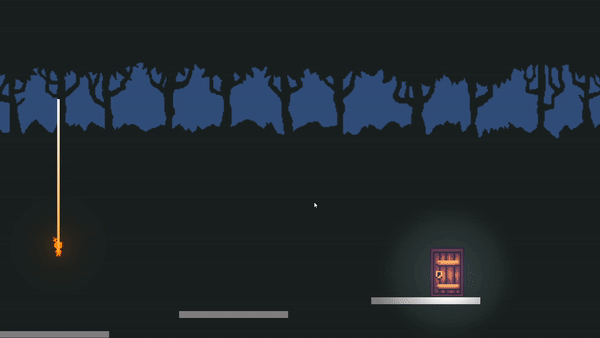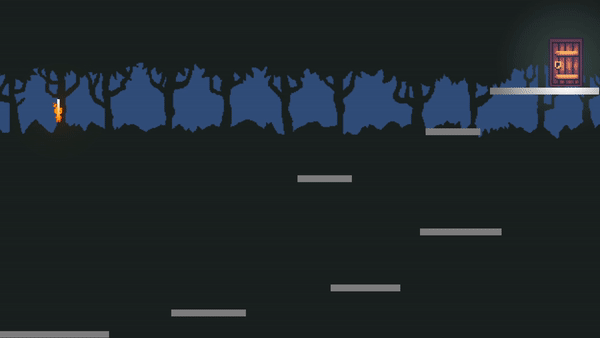What is

A puzzle game that focuses on the rapid memorization of an environment to complete platforming challenges.
Platform(s) - Windows PC
Unity
Date: February 2022 - March 2022
Kevin Pozucek - Design and Programming
A Brief Summary of the Project

Why
Light-Out
I intended to create a puzzle system which focused on the memorization of an environment by momentarily lighting up a stage in order to complete platforming and visual challenges. This would force players to use spatial cognition and memory to plan accordingly as they will not be able to see all obstacles at the same time.
Not only did I want the player to use these senses but also strengthen them through play, and improved performance within the game can be indicative as evidence of this.
The Making of Light-Out
How does it work?
The main mechanic was designed to test a players short term memory.
The player begins the level with the entire level visible but they are unable to move. After a few seconds the stage goes dark, leaving only the player and the door casting a miniscule amount of light.


They must then navigate the level in the dark. If they fall the stage resets, allowing the player to relearn the layout.
An important mechanic is the trail of light that the player leaves behind as they move. This was meant to help players memorize the layout of the level further, tracing the line in their head.
Designing Around Memory
Based on my research into short-term memory the average person has the capacity to remember roughly 7 "items" at a time. This gives me a good target for the maximum amount things I can expect a player to remember. This can range from number of platforms to stage hazards.


It should also be noted that short-term memory store has a duration of up to 30 seconds, which is why I intentionally made it so a level takes no longer then that much to complete.
This video is an example of one of the more difficult levels in the demo. It takes a player about 14 seconds to complete with few errors.
Research Driven Design
Guiding Questions
In my research, I wanted to focus on two very specific aspects of a strategy and logic system, one being spatial awareness and cognition as well as short term memory. The research I performed helped inform and guide my design process in order to make a successful game system. To begin my research I asked myself a few guiding questions...
-
“How reliable is our short term memory?”
-
“How do the visually impaired navigate a world made for those who can see?"
-
"What is function of spatial cognition and what does it actually do for us?"
Using these goading questions I was able to come across a wealth of fascinating information that helped me develop a better puzzle game.
Memory Types
I wanted to look into how memory must be taken into account when designing a game that uses it. I looked into what is called The Multi-Store Model of Memory proposed in 1968 (figure below) which proposes that memory consists of three stores...
-
sensory memory
-
short-term memory
-
long-term memory
Using information about each of these models I can tweak aspects of my game to lend themselves to the forms of memory people use when experiencing stimulation. It should be noted that these forms of memory are said to behave linearly, in which the practice of one can lead to the next respectively.

Of the three forms of memory storage, short term memory is the most relevant to the intended design of the game, however, the previous form of Sensory Memory must be considered as it is what creates the foundation of all memory. The duration of Sensory Memory is exceptionally fast, it stores a constant heavy stream of information directly from our senses and are registered for a brief period, between ¼ to ½ of a second, most of the information taken in is lost by decay almost right away.
Attention is the first step to remembering something and if a person's attention is focused on one of the sensory stores then that data is transferred to the next stage. What this tells me as a designer is that it is imperative to keep a player's attention, especially visually, this means that my game needs to have graphics that draw their attention, pointing to what is important and away from what isn’t. When the player has only a brief window to see what the map of the game is, it is important that I take care to focus their attention on the stages, as this is what they need to remember.
.jpg)


Post Mortem
Meeting Intended Experience
I think I was rather successful at meeting my intended gameplay experience for this project. I think combined with the additional research and feedback from playtesting I was able to successfully create a puzzle system which focuses on the memorization of an environment. Though, of course, the game is not without its flaws. For instance some players found minor success in using the small amount of light to “cheat” and potentially see what is up ahead, instead of relying on memory. This wasn’t an exceptionally good strategy but worked in some cases. I also think that a tutorial could be added before the official stage to familiarize the player with the feel of jumping and moving without risk before continuing.
Overall, I was able to complete a successful prototype of a game system that could be further expanded upon at a future date with additional features, a much more solid foundation with room to grow.


